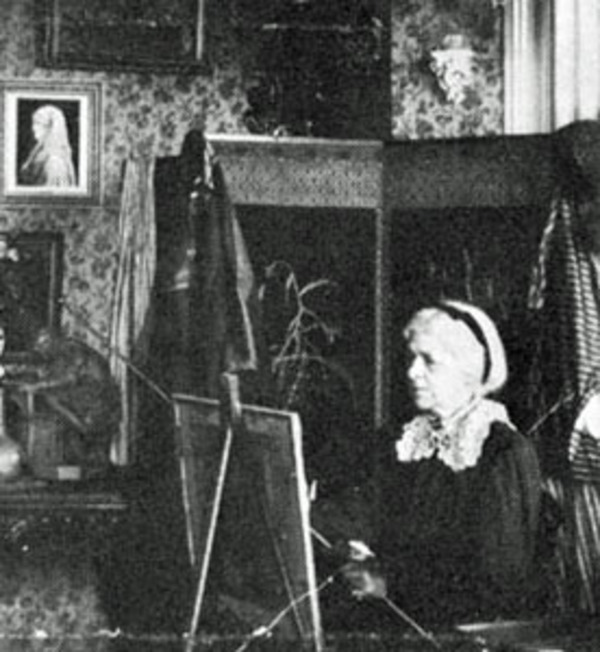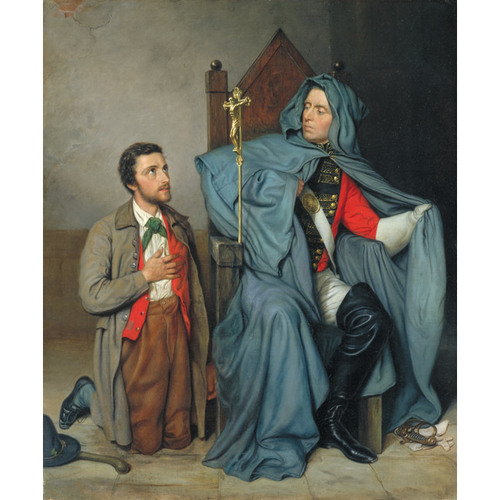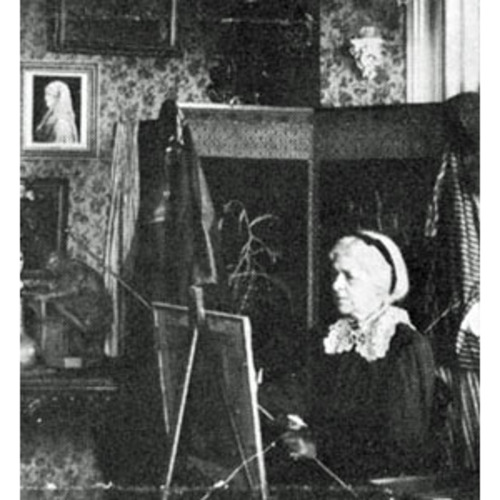
Source: Courtesy of Wikimedia Commons
MORRELL, CHARLOTTE MOUNT BROCK (Schreiber), artist and teacher; b. 21 May 1834 in Colchester, England, eldest daughter of Robert Price Morrell, a Church of England clergyman, and Mary Mount Brock; m. 28 Sept. 1875 Weymouth George Schreiber (d. 5 July 1898) in Witham, Essex, England; they had no children; d. 3 July 1922 in Paignton, England.
Her father’s encouragement of her interest in art enabled Charlotte Mount Brock Morrell to study in London in 1850-55 at Carey’s School of Art. She also took lessons with John Rogers Herbert and instruction in anatomy from a Mr Scharf. In addition to exhibiting with the Royal Academy of Arts between 1855 and 1874, Charlotte illustrated editions of Edmund Spenser’s The legend of the Knight of the Red Crosse (London, 1871) and Elizabeth Barrett Browning’s The rhyme of the Duchess May (London, 1873). In 1875, newly married to her second cousin, Weymouth Schreiber of Toronto, who had three teenaged children, she immigrated to Ontario, locating in Deer Park (Toronto).
Within five years, Charlotte Schreiber’s talent was recognized and she had attained a notable position in the province’s artistic community. In 1876 she was elected to the Ontario Society of Artists; the following year she was the only woman on the board of the Ontario School of Art and from 1877 to 1880 its sole woman teacher. The first female member of the Royal Canadian Academy of Arts, having been appointed at its founding in 1880, she chose to retire in 1888 rather than resign over its prohibition of women attending meetings. Fearless and forthright, she never lost “the fire and enthusiasm of a young girl” ascribed to her at age 60.
Schreiber’s singular achievements as a woman were supported by her ability to produce realistic, popular scenes from literature and everyday life. Paintings of animals, portraits, and romantic, sentimental, and historical depictions were typical. The croppy boy, her diploma painting of 1880 for the RCA and her most famous work (now in the National Gallery of Canada), illustrates a tragic moment from an Irish ballad. As a young patriot makes his confession, the priest reveals himself to be a British soldier in disguise, signifying certain death for the youth. Such compelling narrative scenes put Schreiber in the forefront of conventional Victorian aesthetics. She rejected Impressionism. “Every portion of the living body, the parts of a flower, are divinely beautiful,” the tall, white-haired artist would explain in an interview in 1895. “It is a joy to paint them as they are in reality.” She exhibited with the OSA from 1876 to 1890 and with the Toronto Industrial Exhibition, the Art Association of Montreal, the RCA, and the Women’s Art Association of Canada, of which she was a founding member in 1890. She also showed works in American and European exhibitions and continued to illustrate books, among them a simple poetic prayer by Sabine Baring-Gould, Now the day is over (Toronto, 1881).
In 1884 the Schreiber family moved to its farm near Springfield (Mississauga) on the Credit River, where Charlotte set up a studio in her home, which she named Mount Woodham. She privately tutored such young artists as George Agnew Reid* and Beatrice Mary Walker, who had married one of her stepsons. Her favourite protégé, and sometime model, was Ernest Thompson Seton*, who would become famous as a naturalist writer and artist. Schreiber was also involved in the local community: she played the organ at St Peter’s Anglican Church, helped decorate the sanctuary of a new building, and raised funds through the sale of pet animals and paintings.
In the 1890s Schreiber endured the loss of her two stepdaughters-in-law in childbirth and of her husband. By 1899 she had returned to England and settled in Paignton, where she continued to enjoy a prosperous career, painting until her death at age 88.
[The most complete collection of documents pertaining to Charlotte Mount Brock Schreiber is in the possession of Mrs Beatrice Geary of Ottawa, who kindly shared her archive with the authors. This collection includes a pedigree of the Brock family, photographs of the Schreiber family, copies of magazine articles, newspaper clippings, and catalogues, copies of correspondence between Charlotte and Ernest Thompson Seton, and family correspondence about Charlotte. Margaret Fallis’s “Charlotte Schreiber, R.C.A., 1834-1922” (ma thesis, Carleton Univ., Ottawa, 1985) contains a well-researched biography, an exhibition history, and an illustrated catalogue of 83 of Schreiber’s works. The website of the National Gallery of Canada (Ottawa) also reproduces some of her work: www.gallery.ca. m.p.u. and v.b.]
National Gallery of Canada Library and Arch. (Ottawa), Artist file, Schreiber, Charlotte Mount Brock Morrell. Globe, 2 March 1895. Thompson Adamson, 175 years of history, 1825-2000: St. Peter’s Anglican Church, Erindale, ed. Shirley Stoppard (Mississauga, Ont., [2000]). Betty Keller, Black Wolf: the life of Ernest Thompson Seton (Vancouver, 1984). H. G. Schreiber, “Schreiber pedigree” (typescript, [Toronto], 1960; copy in DCB library).
Cite This Article
Molly Pulver Ungar and Vicky Bach, “MORRELL, CHARLOTTE MOUNT BROCK (Schreiber),” in Dictionary of Canadian Biography, vol. 15, University of Toronto/Université Laval, 2003–, accessed December 15, 2025, https://www.biographi.ca/en/bio/morrell_charlotte_mount_brock_15E.html.
The citation above shows the format for footnotes and endnotes according to the Chicago manual of style (16th edition). Information to be used in other citation formats:
| Permalink: | https://www.biographi.ca/en/bio/morrell_charlotte_mount_brock_15E.html |
| Author of Article: | Molly Pulver Ungar and Vicky Bach |
| Title of Article: | MORRELL, CHARLOTTE MOUNT BROCK (Schreiber) |
| Publication Name: | Dictionary of Canadian Biography, vol. 15 |
| Publisher: | University of Toronto/Université Laval |
| Year of publication: | 2005 |
| Year of revision: | 2013 |
| Access Date: | December 15, 2025 |




